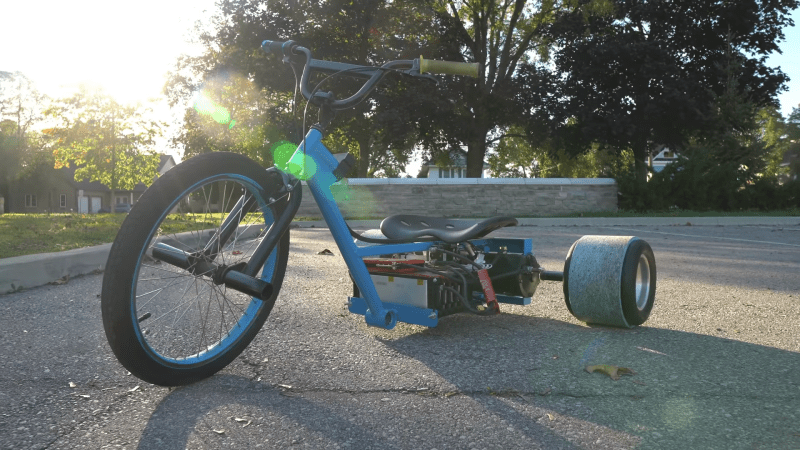Starter motors aren’t typically a great choice for motorized projects, as they’re designed to give engines a big strong kick for a few seconds. Driving them continuously can often quickly overheat them and burn them out. However, [Austin Blake] demonstrates that by choosing parts carefully, you can indeed have some fun with a starter motor-powered ride.
[Austin] decided to equip his drift trike with a 42MT-equivalent starter motor typically used in heavy construction machinery. The motor was first stripped of its solenoid mechanism, which is used to disengage the starter from an engine after it has started. The housing was then machined down to make the motor smaller, and a mount designed to hold the starter on the drift trike’s frame.
A 36V battery pack was whipped up using some cells [Austin] had lying around, and fitted with a BMS for safe charging. The 12V starter can draw up to 1650 amps when cranking an engine, though the battery pack can only safely deliver 120 amps continuously. A Kelly controller for brushed DC motors was used, set up with a current limit to protect the battery from excessive current draw.
The hefty motor weighs around 50 pounds, and is by no way the lightest or most efficient drive solution out there. However, [Austin] reports that it has held up just fine in 20 minutes of near-continuous testing, despite being overvolted well beyond its design specification. The fact it’s operating at a tenth of its rated current may also have something to do with its longevity. It also bears noting that many YouTube EVs die shortly after they’re posted. Your mileage may vary.
For a more modern solution, you might consider converting an alternator into a brushless electric motor. Video after the break.















I think you are confusing solenoid with the Bendix in the article text.
Solenoid drives the Bendix, right? and then once the chemical motor starts the Bendix allows the starter to disengage, so you’d remove the solenoid and jam it in permanent engagement mode for this use?
It was a mite confusing! The video author calls it a “Bendix,” but then goes on to talk about removing a solenoid. Now, a traditional Bendix drive does not have a solenoid, so it seems this is a solenoid starter system?
https://en.wikipedia.org/wiki/Starter_solenoid
https://en.wikipedia.org/wiki/Bendix_drive
I believe we got this right.
The solenoid is a relay/contactor that switches the power to the motor.
The Bendix drive extends the pinion when the motor spins and provides an overrunning clutch.
Both would be removed for an application like this.
Hehe. Reminds me of my first go-cart. Also built with a starter motor.
Power was a car battery, tapped (literally) halfway through with a 1/4-20 tap into the middle bar connecting the cells, giving me two 6V batteries.
No speed control. Just foot-controlled PWM, with the footswitch controlling the motor solenoid.
The bonus of using a 12V battery in two halves: 6V made the top speed just short of “too fast”, and when the first half of the battery died, I moved the jumper cable to the other terminal, and always had enough juice in the other half battery to get home.
Enjoyable intro to electronic vehicles. As the internal combustion engine becomes obsolete, I hope more of us will be building and driving our own DIY electric vehicles, however once you sourced your motor, the other challenging parts are the speed controller and drive train. The “drift trike” I suspect exists mainly as a simple way around requiring a differential gearbox, but though it may provide fun for 20 minutes, renders the vehicle practically useless as a form of transport. The speed controller in the info below the video is way over spec for this task and very expensive, but you can get much cheaper e-bike speed controllers on ebay for a reasonable price.
until we can fly an airliner on electricity, ICE will be anything but obsolete
Or, more importantly, transoceanic cargo transport.
NS Savannah didn’t work out, but it’s been a half century. Maybe it’s time to revisit the notion.
You can already see where this is heading. The one country that has the manufacturing might, the resources, the power plant research program, and the long-term planning mindset, is the one that’s going to own this. Hint: it’s not the USA.
Ice seems to be disappearing pretty quick:
https://www.youtube.com/watch?v=TWMZ6YOIaqI
Wow! You would think that in December it would be expanding.
> It also bears noting that many YouTube EVs die shortly after they’re posted.
I first read that as “many YouTube EV-ers die shortly after”. Glad the hobby isn’t quite that deadly.